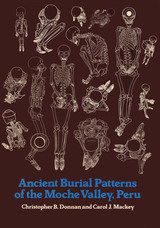
Archaeologists working in the Moche Valley of Peru have uncovered a number of tombs representing various cultures that flourished there prior to European contact. This book provides a full description of 103 such burials, spanning a period of more than 3,500 years. Each burial is documented with an accurate illustration of every artifact found, as well as details on the location, matrix, and construction of the graves, the individuals in the graves, and the placement of all the associated goods. This information constitutes an important resource for solving problems of ceramic chronology and style change. Age and sex data given for the burials will also enable scholars to establish status differences that existed in the pre-Columbian past. Finally, the authors have compared their sample with all the north coast burials previously reported, showing how their findings may be used to ascertain similarities and differences throughout the highland Andean region.
Ancient Burial Patterns of the Moche Valley, Peru is the first diachronic study of burial practices for any Andean region. It not only demonstrates changes in funerary practices in the area but also provides insight into the nature of local cultural development. It will be useful to specialists in Andean and New World archaeology as well as to collectors of pre-Columbian art.

This volume brings together essays on the nature of political organization of the Moche, a complex pre-Inca society that existed on the north coast of Peru from c. 100 to 800 CE. Since the discovery of the royal tombs of Sipán in 1987, the Moche have become one of the best-known pre-Hispanic cultures of the Americas and the focus of a number of archaeological projects. But the nature of Moche political organization is still debated. Some scholars view the Moche as a monolithic state, others see a clear distinction between a northern and southern Moche polity, and yet others argue that the most accurate model is one in which each valley contained an independent polity. In a presentation of new data and new perspectives, the authors debate these competing theories.
Based on a set of papers presented by sixteen international scholars at the Dumbarton Oaks Pre-Columbian Studies symposium held in Lima, Peru, in 2004, this volume marks an important point in the development of Moche archaeology and will be a landmark work in Pre-Columbian studies.

READERS
Browse our collection.
PUBLISHERS
See BiblioVault's publisher services.
STUDENT SERVICES
Files for college accessibility offices.
UChicago Accessibility Resources
home | accessibility | search | about | contact us
BiblioVault ® 2001 - 2024
The University of Chicago Press









